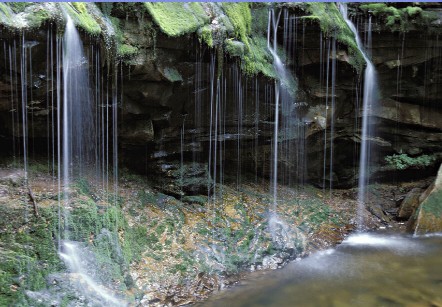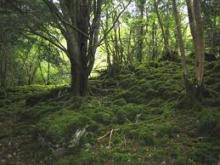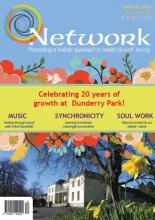Permaculture Principles No. 5

Use and Value Renewable Resources and Services
This Permaculture principle reminds us to look for and tap into the free ecological services supplied by nature. It also asks us to be mindful of our resource use; to consume in a way which supports the renewal and regeneration of the systems from which which we harvest.
Industrial processes
Our modern sewerage system adds chemicals to our water supply to render it 'drinking quality'. We then add our human wastes to this 'clean' water by flushing toilets, & washing & cleaning which often involves more toxic substances from our cleaning agents. The huge amounts of contaminated water that we produce requires treatement once again. Cue industrial scale drains and sewers or septic tanks, yet more chemicals, smelly treatment plants, and so on. It's an energy intensive cycle dependant on large scale industrial processes and all of the implications of that. (pollution, population migration, destruction of ecosystems)
& Free ecosystem services!
In contrast, natural processes clean dirty water for free! Rivers, streams, plants, wetlands, and soils all have the capacity to extract excess nutrients from water and, if we take a couple of steps back, we can engage with these free ecosystem services to safely deal with our wastes. To do this, we first need to avoid the use of toxic chemicals (which appear in the form of many household & personal cleaning products) Secondly, it helps to keep our wastes seperate from our water supply wherever possible.
Compost toilets
“Dry toilets”, also known as “Compost loos” are one simple solution. They use no water or chemicals. Each time we use the toilet we cover our waste with a handful of carbon material; sawdust, straw, or dry leaves for example. Thus we create a balance of nitrogen and carbon, which supports micro organisms and earthworms who transform the mix into valuable compost. With a two bay system, we never have to deal with fresh waste, we just create an environment that allows nature to take it's course - simple as that! Now, the initial 'problem' has now in fact become a resource in itself.

Water
Similarly, other organisms can purify the 'grey water' that we produce. Grey water refers to all the used water that leaves us via sinks, baths & washing machines. Again, we want to create the right conditions for micro organism life, so it's a case of first taking a step back by not contaminating the water with toxic cleaning agents and washing powders. We then have a nutrient rich water which can be purified by bacteria and plants who love these conditions. Soils and stones can support these bacteria and plants and gravity can also help to aerate the water through a passive flow system down a slope. Here again, a 'problem' has become a resource through the use of natural and free ecosystem services.The once dirty water can be directed into a fish pond or used to irrigate our gardens.
Gardens
There are endless ways we can employ biological processes in our gardens. We can create the conditions for earthworms and other soil life to aerate and till our soils thus reducing the need for using rotavators. The iconic 'chicken tractor' can also help with this, and of course pigs dig even deeper. Ducks & frogs can help to control slug populations and rabbits and geese can mow our lawns. Deep rooted perrennial plants can help to decompact the soil and living hedges can provide a myriad of benefits and yields when used in place of a fence as a barrier or windbreak. All of these examples are non-consumptive, in other words, we don't have to harvest anything to get the benefits, (although in some cases we obviously can harvest surpluses such as eggs!)

Renewable resources
In other cases we do need to take something out of the system. So where possible we want to use renewable resources. Trees are the obvious example. They are the great sunlight harvesters - natures solar power plants! We mentioned coppicing in a previous article as a way to appropriately harvest wood for timber, firewood, power, and building. Coppicing is a method of cutting trees in a manner which enables them to re-grow. It's a bit like pruning back a herbaceous perrennial. A well managed coppice can sustainably supply wood (& other forest products such as mushrooms, fruits, grazing, in the meantime). It can extend the life of each individual tree, and also increase the diversity and productivity of the woodland ecosystem as a whole. Coppicing can be done on a small or large scale. Some trees like Willow can be harvested annually and biennually whereas other such as Ash which is slower growing needs to be on a rotation of about 10 years.
'Use & value renewable resources and services' is a principle which really reminds us to appreciate and support our “intimate partnership with nature” .
These are just a few examples of how we can use & value renewable resources and services. We could also think about how it can be applied in other contexts too. Think about the resources you use in your own life, where do they come from? Where do they go when they leave you? Can you think of ways in which the function they serve could be served by a natural process? Or supplied by a resource that can be renewed in reasonable time? It would be great to hear some ideas in the comments space below...
Hannah Mole is an Organic farmer, Gardener and Permaculture teacher and designer, living in County Roscommon. For more info, events and courses see www.hannahmole.com
Latest Issue
Upcoming Events
-
17/04/2020 to 26/04/2020
-
18/04/2020
-
23/04/2020
-
15/05/2020 to 23/05/2020
-
16/05/2020 to 17/05/2020
Recent Articles
Article Archive
- November 2011 (2)
- January 2012 (3)
- February 2012 (2)
- March 2012 (2)
- April 2012 (4)
- May 2012 (4)
- June 2012 (1)
- July 2012 (3)
- August 2012 (2)
- October 2012 (2)

